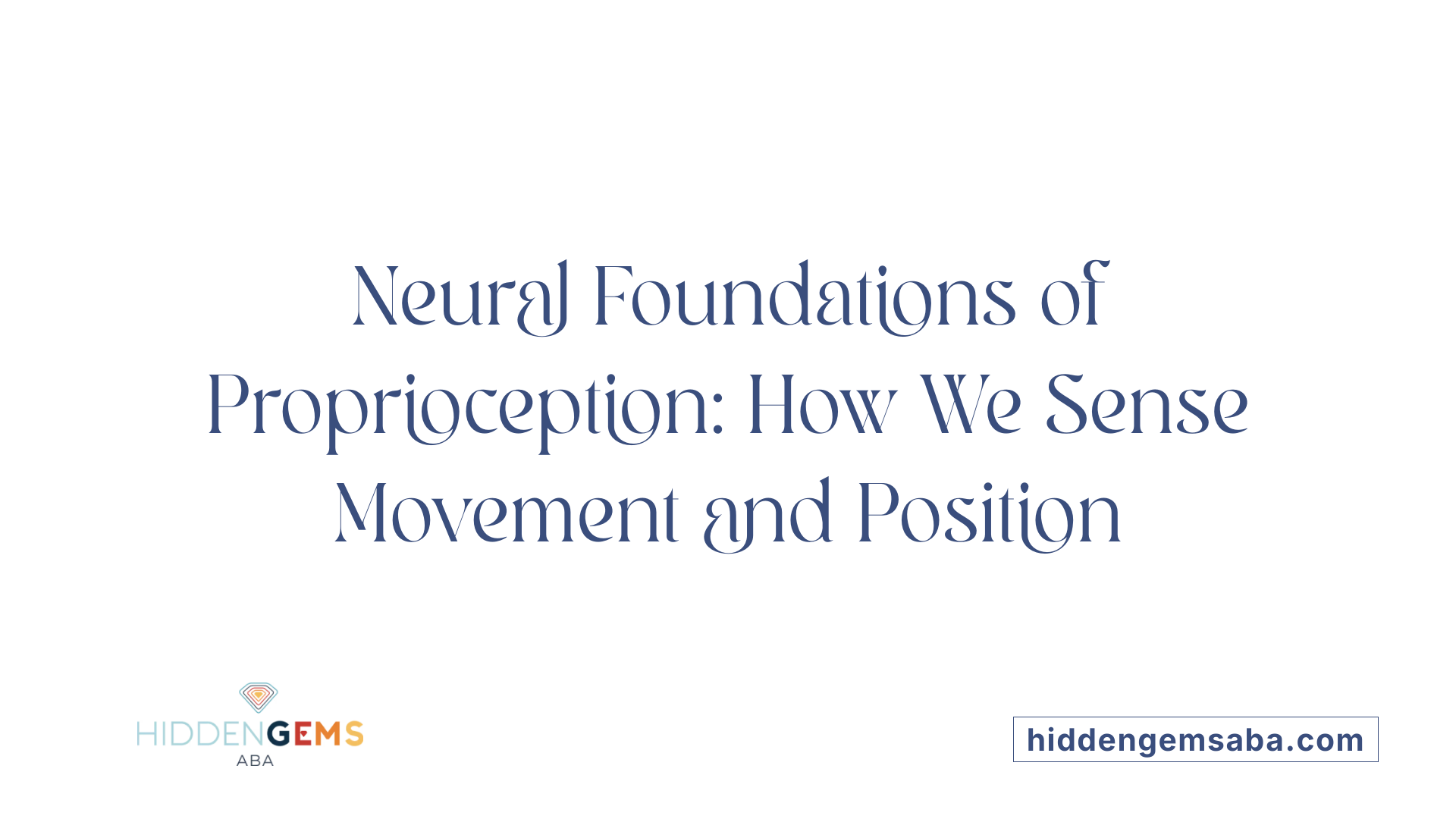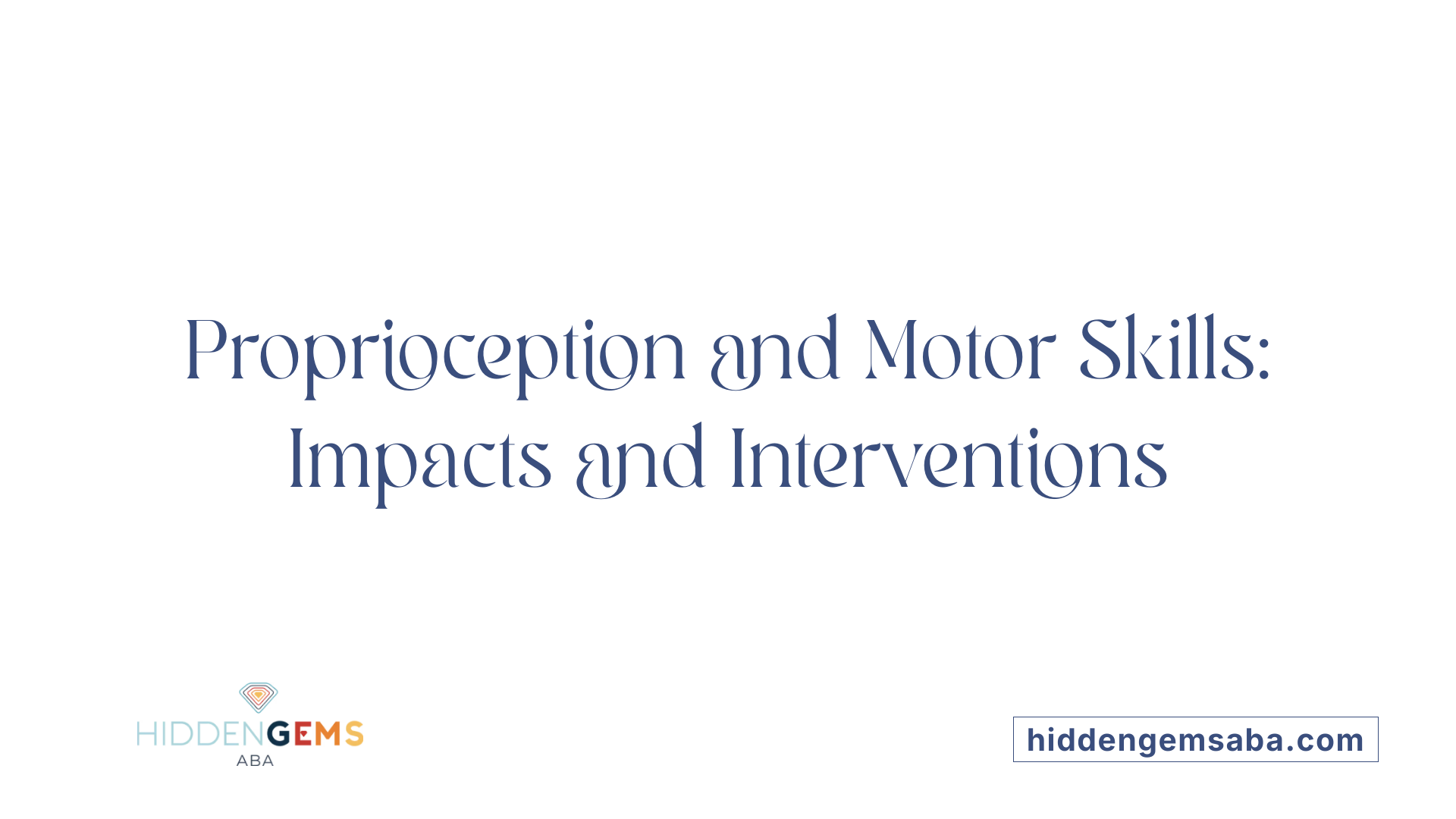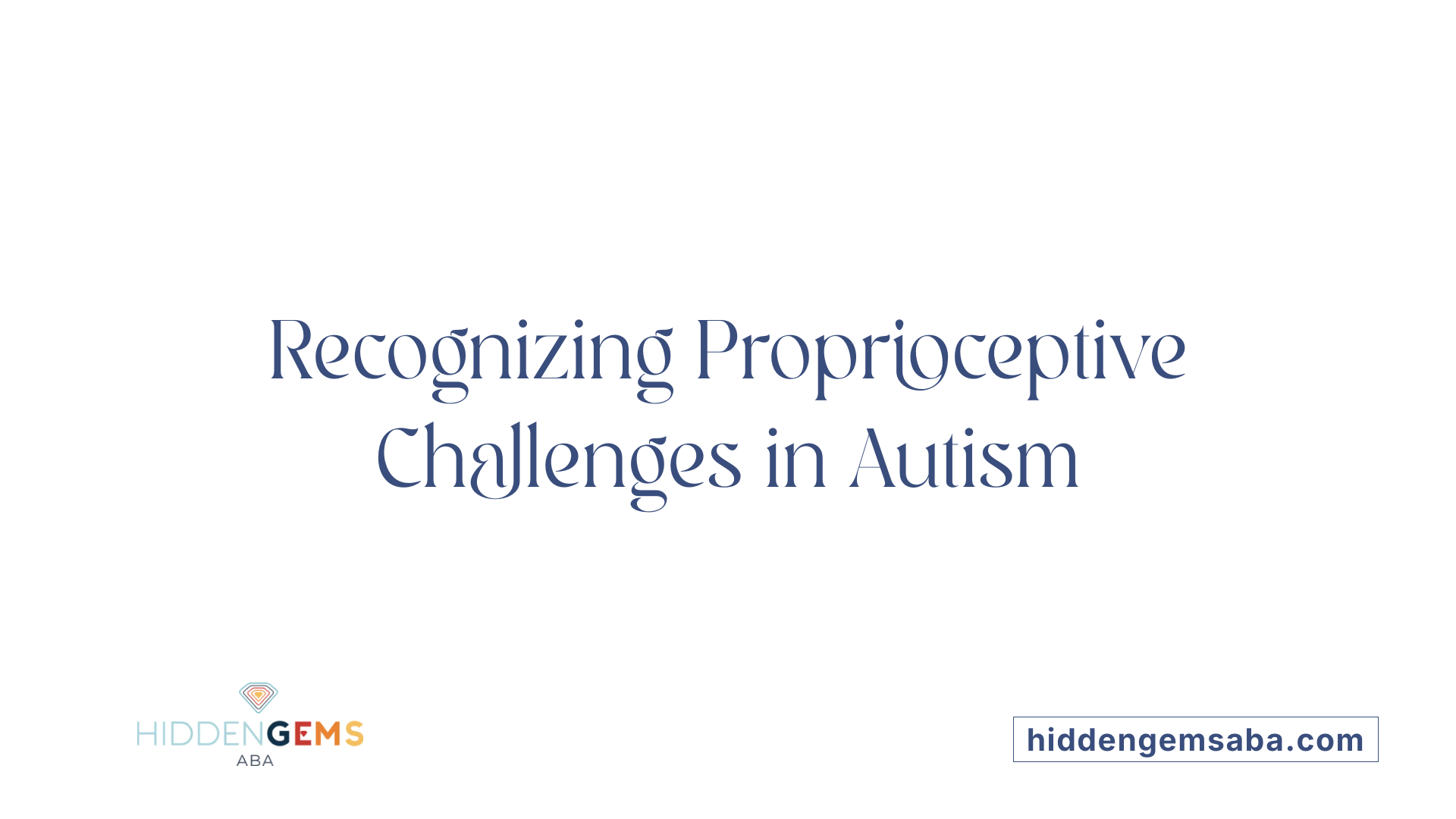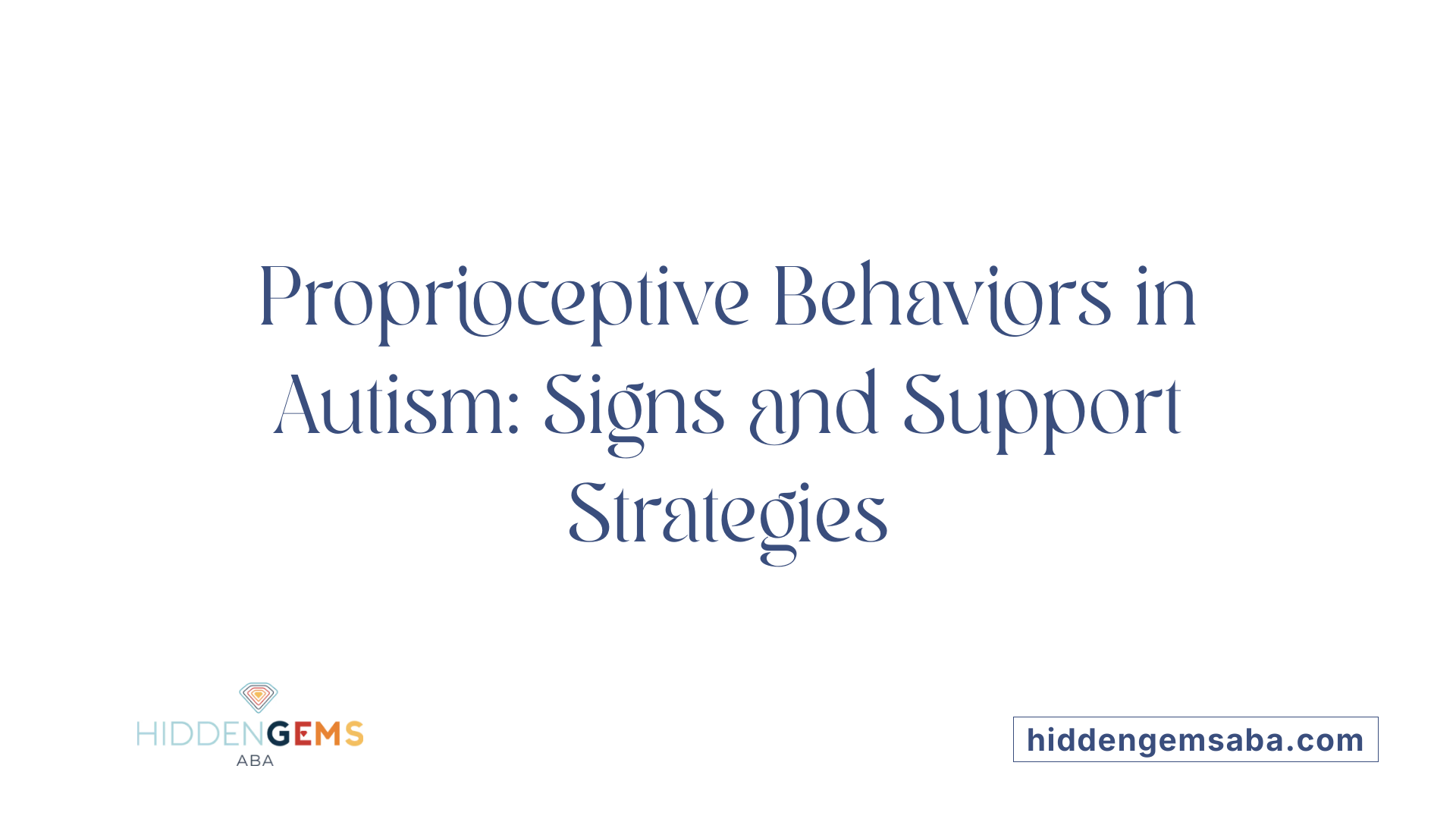Exploring the Sensory Foundations of Autism
Proprioception, often called the body's sixth sense, plays a vital role in how individuals with autism perceive, interpret, and respond to their environment. This sense, which is often underappreciated, involves awareness of body position and movement, allowing for coordinated action, balance, and emotional regulation. For children with autism, proprioceptive processing difficulties can significantly impact daily functioning, learning, and behavior. This article delves into the complexities of proprioception in autism, highlighting signs of challenges, their effects on behavior, and strategies to support sensory regulation.
Defining Proprioception and Its Neural Foundations

What is a proprioceptive sense?
Proprioception is the body's ability to sense its position, movement, and pressure without the need for visual cues. It relies on specialized sensory receptors located in muscles and joints that constantly send information to the brain.
These receptors, known as proprioceptors, include muscle spindles and joint receptors. They detect changes in muscle stretch, joint angle, and pressure, providing critical data for the brain to interpret.
Location and function of proprioceptive receptors in muscles and joints
Proprioceptive receptors are situated in various parts of the musculoskeletal system. Muscle spindles, found within muscle fibers, monitor stretch and muscle length. Joint receptors, present in ligaments and capsule tissues, sense joint position and movement.
Together, these sensors enable the brain to form a detailed map of body position and movement. This information allows for smooth, coordinated movements and postural stability.
Role of proprioception in body awareness, movement control, and pressure regulation
Proprioception plays a vital role in body awareness, helping individuals understand where their body parts are in space even with closed eyes.
It is crucial for movement control, assisting in motor planning, balance, and coordination. For instance, when walking or reaching for an object, proprioceptive input guides accurate movements without visual reliance.
Furthermore, proprioception helps regulate force and pressure application. This is essential for tasks like gripping or pushing, ensuring actions are performed with appropriate intensity and safety.
In children with autism, proprioception is often disrupted, leading to challenges in balance, motor planning, and behavior regulation. Engaging in proprioceptive activities, such as heavy lifting or deep pressure, can help improve these functions and promote emotional regulation.
Proprioception and Its Impact on Motor Skills in Autism

How does proprioception affect individuals with autism, including sensory regulation and behavior?
Proprioception is often called the body's 'sixth sense' because it provides essential feedback about body position and movement without needing to look. For individuals with autism, this sense plays a vital role in how they perceive their body in space, regulate sensory input, and behave in their environment.
Research indicates that many children with ASD experience proprioceptive processing difficulties. These challenges can manifest as problems with feedback-related motor planning, which is the ability to coordinate movements smoothly and accurately. For example, children may struggle with tasks that require precise motor control, such as balancing or using their limbs effectively.
Specific behaviors linked to proprioceptive difficulties include tiptoeing, crashing into objects or people, pushing others, and engaging in rough play. These behaviors often serve as attempts to seek proprioceptive input, which can be calming for autistic children. As a result, they may prefer vigorous activities like jumping, heavy lifting, or pressing, which help them self-regulate emotional and sensory responses.
A study utilizing the Comprehensive Observations of Proprioception (COP) tool found that children with ASD show greater difficulty in proprioceptive feedback tasks compared to their typically developing peers. This impairment correlates with challenges in postural control and motor coordination, leading to clumsiness, poor posture, and occasionally disruptive behaviors.
Moreover, proprioceptive difficulties can contribute to emotional dysregulation. When sensory processing isn't well-organized, children may become overwhelmed, anxious, or frustrated, which can lead to meltdowns or withdrawal. Addressing these challenges through targeted proprioceptive activities—such as resistance exercises, deep pressure, and weightbearing tasks—can promote better sensory regulation.
In summary, proprioception significantly influences behavioral responses and motor skills in individuals with autism. Enhancing this sense through specific activities not only improves coordination and posture but also reduces disruptive behaviors and supports emotional well-being.
Signs and Characteristics of Proprioceptive Differences in Autism

What are the signs of proprioception issues?
Signs of proprioception issues often manifest through difficulties with balance, coordination, and body awareness. Children may frequently fall or wobble while walking or standing, showing unsteadiness and poor postural control. Clumsiness is common, such as having trouble judging how much force to use when writing or grabbing objects, which can lead to difficulty with daily tasks.
People with proprioceptive challenges might also experience dizziness or disorientation, which affects their spatial awareness. They may overshoot or undershoot movements, like reaching for a doorknob or stepping onto a curb, indicating impaired body position sensing.
Furthermore, these children often seek intense sensory input to help regulate their nervous system. They might display behaviors such as biting objects, banging their body parts, or engaging in heavy play activities like jumping or crashing. These behaviors serve as a way to gain proprioceptive feedback, helping them feel grounded.
In addition, many children with autism rely heavily on proprioception instead of visual cues to guide their movements, which can sometimes lead to safety concerns or behavioral issues. Recognizing these signs is crucial for implementing supportive interventions that improve coordination, posture, and emotional regulation.
Proprioceptive Sensory Behaviors and Manifestations in Autism

What are common characteristics and symptoms of proprioceptive differences in individuals with autism?
Individuals with autism often show distinctive proprioceptive behaviors that influence their motor skills and daily activities. These differences manifest in clumsiness and poor body awareness, making it challenging to coordinate movements smoothly. Such individuals may struggle with motor planning, leading to awkward postures and difficulty performing tasks that require fine or gross motor skills.
Many children with autism seek proprioceptive input to self-regulate their sensory systems. Indicators include behaviors like biting objects, jumping vigorously, rough play, or banging body parts. These actions provide the intense proprioceptive input they crave, which can have a calming or alerting effect depending on their needs.
Sensitivity to movement and pressure varies among autistic individuals. Some may be hypersensitive, reacting negatively to light touch or tight clothing, while others seek strong stimuli, such as heavy lifting or vigorous activities, to feel more grounded. These behaviors often reflect underlying sensory processing differences and are crucial for their emotional and behavioral regulation.
Postural challenges and clumsiness are common, affecting balance and coordination. Such motor difficulties can sometimes lead to frequent falls or trouble with sports and daily tasks. These symptoms highlight the importance of interventions that focus on providing appropriate proprioceptive input.
Engaging in targeted activities like resistance exercises, weightbearing tasks, and deep pressure can help improve proprioceptive processing. Such strategies support better body awareness, enhance motor coordination, and help reduce maladaptive behaviors by meeting the sensory needs of children with autism.
In summary, recognizing and supporting these proprioceptive behaviors through tailored interventions can significantly improve functional skills and emotional regulation, fostering greater independence and well-being.
Proprioception’s Role in Emotional Regulation and Behavioral Responses
How does proprioception affect individuals with autism, including sensory regulation and behavior?
Proprioception, often called the body’s 'sixth sense,' is crucial for body awareness and movement control. In individuals with autism, proprioceptive processing can be quite different from typically developing children and those with other developmental disabilities.
Children with ASD frequently encounter challenges with proprioceptive input, which influences their motor planning and postural control. These difficulties can manifest in behaviors such as tiptoeing, crashing into objects, falling, or pushing others. Such behaviors may serve as attempts to seek sensory input or self-regulate their nervous system.
Research utilizing the Comprehensive Observations of Proprioception (COP) tool indicates that children with ASD display greater proprioceptive processing issues compared to their peers. These issues are linked to decreased motor coordination and can lead to disruptive behaviors, impacting their daily participation and social interactions.
Proprioceptive deficits also relate to emotional regulation. For example, children who struggle with proprioception may experience heightened emotional lability, including outbursts or withdrawal, due to their difficulty in maintaining body awareness and sensory stability.
Supporting proprioceptive needs through targeted activities—like heavy lifting, resistance exercises, or deep pressure—can promote calming and alerting effects. Such interventions help children better process sensory stimuli, improve coordination, and foster emotional stability.
In summary, addressing proprioception in children with autism is vital for improving their behavior and emotional well-being. Incorporating sensory-rich activities tailored to proprioceptive input offers a promising approach for enhancing self-regulation and diminishing disruptive episodes.
Assessment Tools and Therapeutic Strategies for Proprioceptive Support
Many children with autism experience difficulties with proprioception, which can impact motor planning, posture, and behavior. To better understand and address these challenges, clinicians use a variety of assessment tools. One notable instrument is the Comprehensive Observations of Proprioception (COP), which has demonstrated sufficient validity and reliability for both clinical and research purposes. The COP helps identify specific proprioceptive impairments, such as problems with feedback-related motor planning, tiptoeing, pushing objects or others, crashing, falling, and running.
In addition to COP, there are specific assessments and tests designed to evaluate proprioceptive functioning comprehensively. Laboratory-based methods like the threshold to detection of passive motion (TTDPM), joint position reproduction (JPR), and active movement extent discrimination assessment (AMEDA) can measure sensory detection, reproduction accuracy, and discrimination abilities. Clinical evaluations, including the Romberg test, heel-shin test, finger-nose-finger test, and joint matching tasks, assess how well a person perceives and coordinates their body movements during functional activities. Balance error scoring systems and dynamic balance tests provide insight into postural control, which is closely linked to proprioceptive processing.
Therapeutic activities typically involve providing input to muscles and joints to support regulation. Resistance activities such as pushing, pulling, and heavy lifting stimulate proprioceptive receptors, helping children improve body awareness and self-regulation. Weightbearing exercises like crawling and push-ups, deep pressure activities such as tight hugs or squeezing, and oral activities including chewing or blowing bubbles are also effective.
When integrating these activities, consider their purpose—whether to calm or alert the child. Timing is critical; activities are most beneficial when introduced before anxiety triggers or when a child is disengaged. Short, frequent sessions tend to be more effective. The environment should be adapted based on the child's preferences and sensitivities, whether inside or outside the classroom, and should include options like chair-based exercises, functional movements, or weighted resources.
Supporting proprioceptive needs through environmental modifications and activity planning enhances a child's ability to self-regulate, balance, and participate in daily activities. Combining these strategies with a variety of assessment tools allows for tailored interventions that address individual needs and improve overall sensory integration.
Harnessing Proprioceptive Activities for Regulation and Growth
What strategies and activities support proprioceptive processing in individuals with autism?
Supporting proprioceptive processing involves activities that provide deep pressure and joint compression, helping children with autism feel grounded and more in control of their bodies. Using weighted items or resistance tools can deliver calming input, assisting with body awareness.
Activities like pushing or pulling objects, swinging, bouncing, and crawling are especially effective in stimulating the proprioceptive system. These movements help improve motor planning, coordination, and self-regulation, reducing disruptive behaviors.
It is essential to tailor activities to each child's unique sensory preferences and needs. For some, vigorous activities can be alerting, while for others, gentle weighted stretches may be calming. Integrating these interventions into daily routines can support emotional balance and focus.
When and how often should proprioceptive activities be incorporated?
Timing is crucial when introducing proprioceptive exercises. They are most beneficial before anxiety triggers or moments of disengagement to prepare the nervous system.
Frequency should be short and frequent, often several times a day, to sustain benefits without causing fatigue. Consistent incorporation helps children develop better body awareness and emotional regulation.
Locations for these activities can be inside or outside the classroom, depending on the child's comfort. Common settings include quiet corners, sensory rooms, or playground areas.
Combining proprioception with other sensory strategies
For comprehensive support, proprioceptive activities work well alongside other sensory interventions, such as vestibular input (movement and balance activities) and tactile experiences.
This combined approach ensures a rounded sensory regulation plan that addresses over- or under-sensitivity across senses.
Activities like yoga, resistance exercises, and oral motor tasks can complement proprioceptive input. Environmental adjustments, such as weighted blankets or quiet spaces, enhance the effects.
Implementing a variety of strategies tailored to individual needs enables children with autism to develop better sensory integration, emotional health, and overall confidence in their daily activities.
The Path Forward in Supporting Sensory Integration
Understanding and addressing proprioceptive processing challenges in children with autism is essential for fostering better motor skills, emotional regulation, and overall well-being. Comprehensive assessments, targeted therapeutic activities, and environmental modifications can make a significant difference in improving their quality of life. Continued research and tailored interventions will further clarify how best to support these individuals, ultimately promoting resilience, independence, and emotional stability.
References
- Proprioceptive Processing Difficulties Among Children With Autism ...
- Proprioceptive - Best Practice: Sensory - Middletown Centre for Autism
- What is Proprioception? - Bristol Autism Support
- Sensory differences - a guide for all audiences
- Proprioception, Emotion and Social Responsiveness in Children ...
- Proprioceptive Input for Children with Autism
- Sensory Integration in Autism Spectrum Disorders
- Proprioception Exercises for Autism Support






